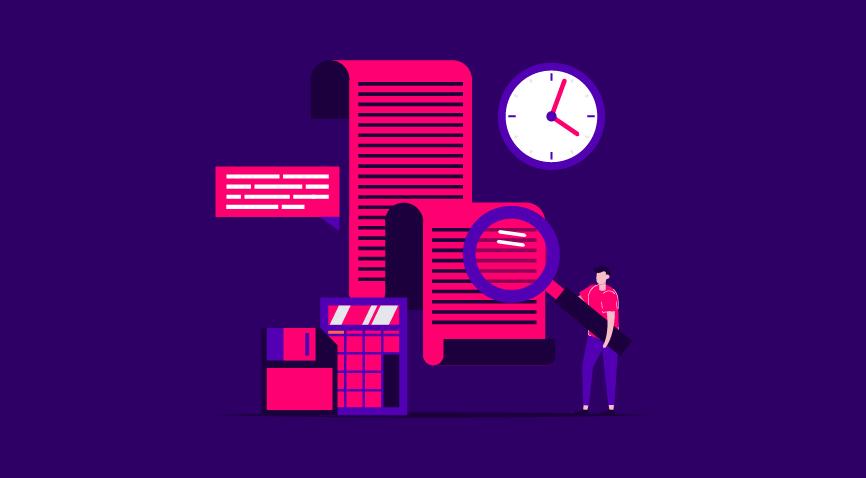
Table of Contents
- What is Content Editing?
- Why is Content Editing Important?
- What are the Types of Editing that your Content Needs?
- Key Takeaways
- Conclusion
- FAQs
Every piece of content requires a different type of editing to ensure that the message is conveyed in the best possible way. Editing is necessary for all types of content to make it more readable and apt for the chosen target audience. Such content always attracts more readers or customers. If you wonder what content editing is, here is a breakdown of the processes involved in content editing and the types of content editing.
What is Content Editing?
There are different types of content editing necessary to ensure optimum quality at every stage of the writing process. If you’ve been writing for a while, you already know that the process of content writing is essentially divided into five parts:
- Prewriting
- Drafting
- Revising
- Editing
- Publishing
To put it simply, content editing is the process of evaluating one’s writing by breaking down the content’s style, tonality, grammar, and comprehensiveness. While some pieces of content don’t need to be edited for long, other forms like novels and case studies tend to need more intensive editing.
Ultimately, the different types of content editing that the piece of content goes through make it clear, and easy to read. The touch of an editor transforms the text to suit the eyes of the most ordinary reader. After a series of content edits, some authors also prefer to make their text undergo different types of copy editing to ensure that the final piece is pristine and free from the most minute errors.

Why is Content Editing Important?
Many businesses tend to skip the process of content editing or even the types of copy editing. Some do not even feel it necessary to hire a content editor. After all, who’s going to sit down and waste their time on reading a piece of content that’s already been re-read by the writer? WRONG!
Content editors are meant to be a separate entity from the writers mainly because a fresh pair of eyes get to interact with the content. As the writer, you become one with your work, making it difficult to separate yourself from the piece of content. It becomes difficult to assess the work from the point of view of a reader that holds no context to your subject, ultimately making your content rather confusing when viewed from the eyes of a third person. Do not underestimate the processes of content editing if you want to upgrade your content.
However, if you manage to get a reliable content editor on board, you will gain access to the following advantages:
- Content editing is meant to make your writing better
What does an editor do? A good content editor sticks to the originality of your content and tweaks it to bring out the ‘you’ in your content better! By matching the tonality, editing (and not rewriting), and grammatical corrections, a good content editor will help improve your writing. The different types of editing would ensure that your final document is impeccable.
- Your writing will become more organized
We can write, but it can be difficult to structure it in a way that doesn’t seem like it’s all over the place. This is where the types of content editing help. With the use of a table of contents, a division of H1, H2, and H3 for search engine optimization templatizing, and by highlighting the core keywords of the content, content editing helps the reader get a better grasp of the content without it seeming too blank and boring. The different types of editing also make sure that these formatting changes and SEO inputs do not hamper the original quality of your writing. Content relevance takes precedence over SEO optimization. Though, it is imperative that we pay attention to both to make our websites rank.
- A clear paragraph structure is formed
Organizing your content doesn’t just mean building a template to set it apart into different topics; it means building a clear paragraph structure. For example, did you know that limiting a paragraph up to 3 to 4 lines in a digital blog is recommended to ensure there’s enough white space and not too much text that ultimately intimidates the reader? The different types of content editing would ensure that your final piece is ready to be published.
So while you might question, ‘What is editing in writing?’ it’s important to remember that content editing is meant to help make the write-up much more reader-friendly than it was before.
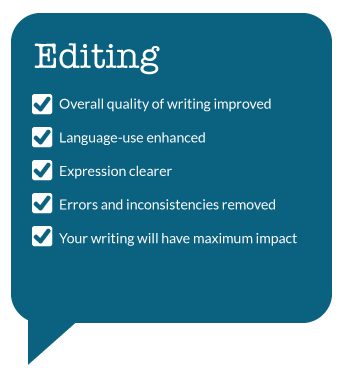
- Editing can help bring forth the clarity your content needs
When you write an article or a blog, there are many terms that you might use that are a part of your general vocabulary. However, we often forget that not every reader on the internet needs to know the meanings of those terms.
The key to good writing? Make it simple. The types of content editing help you clarify your thoughts by adding definitions wherever necessary, turning slang into general terms, and turning abbreviations into everyday words.
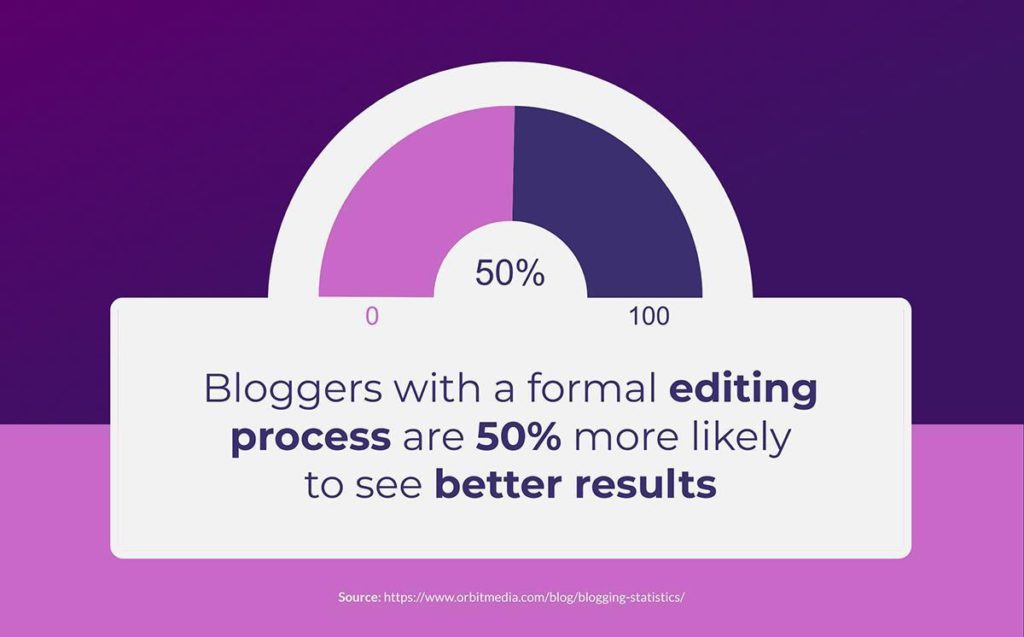
While the advantages will keep lining up as the job gets done, the question is, what type of editing do you need for your content?
It all depends on the rigorous standards of the content being developed. There are many ways in which you can edit content. However, the basic principle of all types of editing is to allow a consistent, grammatically accurate, and error-free message flow.
While there are many different types of editing, not every editor uses the same approach. Most editors use a mix of one or more approaches to assess, evaluate and improve content.
In this post, we will cover five basic types of editing every writer should know about – to help you avoid asking yourself the question, “What are the types of editing that I should know about?”
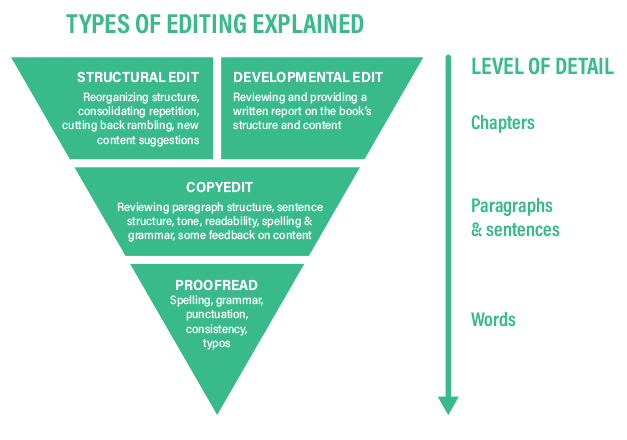
What are the Types of Editing that your Content Needs?
1. Developmental editing
Developmental editing, also known as conceptual editing or manuscript appraisal, is done at an early stage in the writing process when an author has an idea or a rough outline but needs help to stitch it all together.
A developmental editor sees the big picture of your book, manuscript, article, or any other content piece by focusing on your ideas’ structure and organization, rather than just the choice of words, grammar, and punctuation. This approach ensures that the structure or organization of your copy is aligned with the stories or messages being conveyed.
The goal of developmental editing is to answer key questions that can amp up the strength of your writing style. Developmental editing does not involve writing or rewriting but offers suggestions to better organize a writer’s ideas.
Questions asked during the developmental editing process may include:
- Are you leaving out any key information?
- Is there irrelevant content that needs to be removed?
- Will people enjoy the style and flow of ideas in the story?
Developmental editing is the type of content editing that ensures your content is visualized through a reader’s eyes, offering feedback that helps improve the reading experience.

2. Evaluation editing
Evaluation editing or structural editing is done when an editor looks at a manuscript to evaluate the structure, completeness, flow, and overall quality of writing. In this type of editing, the writer is offered short suggestions and memos to address the key areas of concern in the flow of content. Focusing on the structural integrity of writing, an evaluation edit also focuses on the big picture.
The critical difference between an evaluation edit and a developmental edit is that you need a completed piece of content for evaluation. In contrast, developmental editing starts at the ideation stage itself. Once you have received a good review for your writing, your content may be ready for proofreading or copyediting.
Since you have to present a complete manuscript for an evaluation edit, the goal is to safeguard your book from further revisions, with enough attention to the readability, flow of thought, and vocabulary chosen. The editor may also offer suggestions to improve your content, thereby furnishing a channel for exchanging ideas during the editing process.
3. Content editing
Content editing is also called full editing or substantive editing. In this type of editing, an editor digs into the words on a page. Unlike developmental and evaluation edits, the content editor carefully edits the manuscript with keen attention to sentence structures, ideation, and choice of words.
A content editor offers a paragraph-level markup on any piece of content, with corrections, suggestions, and advice. The focus is also on the voice or tone of content, which significantly impacts a reader.
A content editor should be aware of the target audience as well and edit accordingly. Additionally, they will make sure that your content is authentic.
A content editor won’t modify chapters but usually moves sections and paragraphs around within a chapter or removes unwanted or irrelevant text. Unlike line editors (more on them below), the types of content editing do not format the decorative elements of your sentence structure.
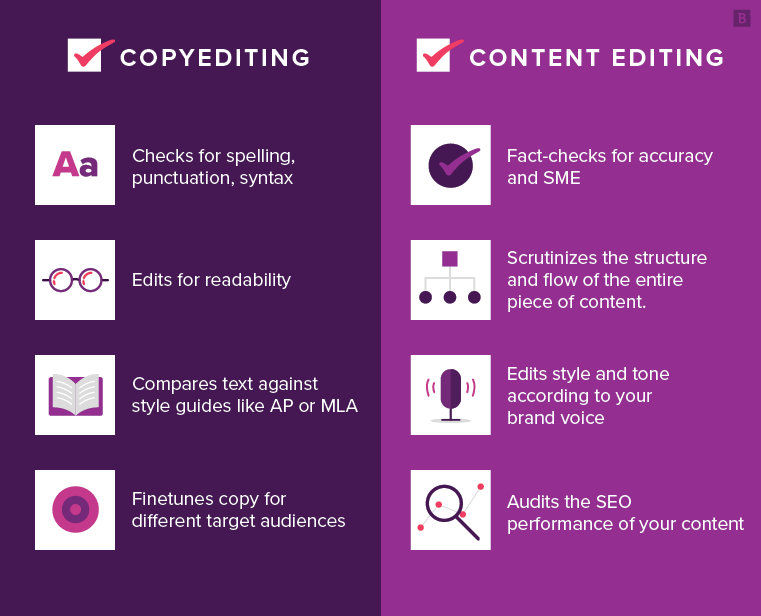
4. Line editing
Line editing is also called stylistic edit or comprehensive edit, where a line editor offers a line-by-line review for any content manuscript. While developmental, evaluation, and content editing processes involve a high-level analysis of your content, this type of editing is meant to refine the vocabulary, tone, message, and sentence structure.
A line editor doesn’t review an entire book, a chapter, or paragraphs. Rather, the line editing process involves keen attention to every sentence in the manuscript. Jumping into the manuscript with both feet, line editing provides a detailed edit where your structured content begins to sing.
As a writer, it is important not to jump into line editing before your content is properly structured and organized. That’s because this type of editing focuses on the minuscule aspects of grammar, punctuation, choice of words, and imagery to bring out the most in each sentence.
Like every other type of editing, line editing also focuses on the flow of your content. The line editors are more concerned with how each word in a sentence mingles with others to create a dynamic reading experience.
Line editors suggest improvements on run-out sentences, fragmented sentences, and cliches. They help a writer clarify the meaning of a sentence, eliminate complex jargon and ensure that each sentence offers high readability. By tightening the sentences, line editing offers streamlined structural integrity at the sentence level of a manuscript.
A line editor is not concerned with errors in the structure of your sections but is more concerned with words used to communicate with readers. Line editing involves simplifying, shortening, and making each sentence precise for easy readability and relatability.
While line editing is quite similar to copyediting, their suggestions are usually less critical.
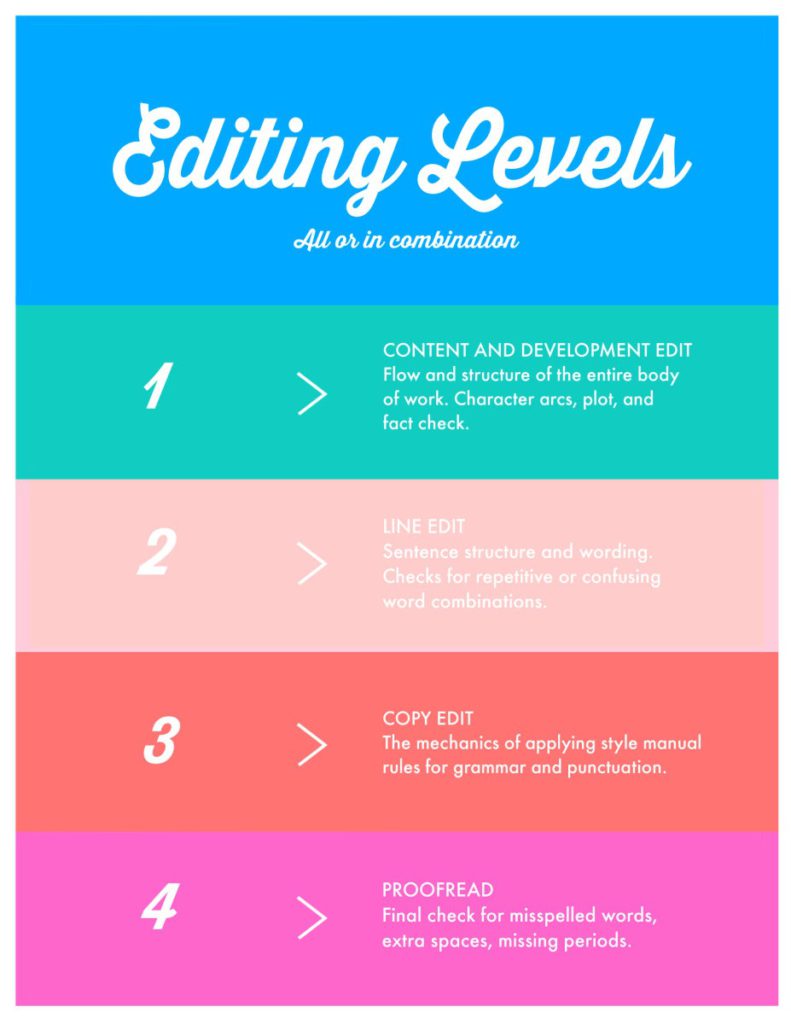
5. Copy editing
When a manuscript or a piece of content is completed, you have to fill the gaps and ensure its quality is retained even after editing. A copy editor must carefully go through the manuscript and find spelling, punctuation, and grammatical mistakes at the final editing stages. This is usually the last stage in the different types of editing.
No matter how refined your language may be, there could be minor errors that can dent the quality of your writing. Copyediting ensures that there are no mistakes left in the final draft.
On average, only 60% of people detect errors, and professionals may catch up to 85% of errors in writing. Copyediting minimizes the errors and offers the best version of a final manuscript.
While copy editing is different from proofreading, it is assumed that all writers proofread their content before submitting it for editing or publication. Yes, the proofreading process is just as important.
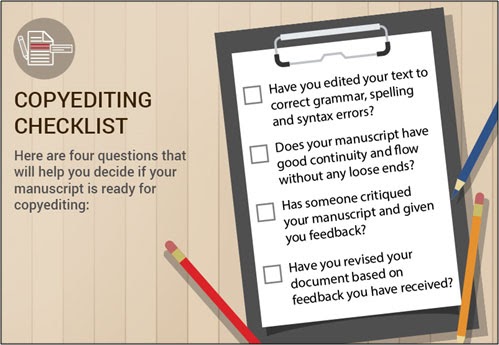
Key Takeaways
- If you wonder what content editing is, the above piece is most suited to your needs. It comprises the necessary steps to ace different types of editing.
- Often, writers are too attached to their work to judge it effectively. Different types of editing processes would make the content easy to read.
- Different types of editing ensure that your writing has a clear structure with distinct paragraph segmentation.
- Developmental editing is the type of editing that is done at an early stage when an author has an idea or a rough outline but needs help to stitch it all together.
- Evaluation editing or structural editing is the type of editing that is done when an editor looks at a manuscript to evaluate the structure and flow.
- Content editing is the type of editing when an editor carefully probes the manuscript with keen attention to sentence structures, ideation, and choice of words.
- Line editing comes much later. It is the type of editing where an editor reviews and comments on every line.
- Copyediting is the type of editing that ensures no mistakes in the final draft.

Conclusion
Do not skip editing if you want to ensure quality. All it takes is relentless focus or attention to detail at the end of the day. An efficient editor would go through the content piece, point our misspelled words and grammatical errors, and analyze the tone of the piece. If you talk to your editor about our target demographic, they would be able to judge if the content piece would appeal to them. Every writer should be aware of these five types of editing to ensure that their piece of content meets the quality standards before it is sent for editorial review.
FAQs
Trying to decide which content editor would fit your requirements best? It doesn’t have to be so hard. There are essentially four different types of editors:
1. Developmental editors: They help you tackle the organization of your content, the overall structure, the tone of voice, and character development (if required). Depending on your needs, the developmental editors are meant to help you skim through the first steps of your content creation.
2. Substantive editors: Also known as Line Editors, Substantive Editors help you get more clarity and style in your writing. This can vary from rephrasing certain statements here and there to complete modification of whole paragraphs.
3. Copy editors: The most popular of the bunch, copy editors help you overcome your grammatical errors while also working on inconsistent language barriers. They only perform light modification and tend to help you get consistency throughout your article, blog, or novel.
4. Proofreaders: Typos, grammatical errors, and the overall syntax of your text are analyzed by proofreaders. The proofreaders are the last content editors you tackle in your race of editing before you go forward and publish your work. Your content piece needs to go through types of copyediting to ensure optimum readability at the final level.
Depending on the needs you hold, you may require just one content editor or all four of them.
To put it simply, editing is the process of revising the content structurally, grammatically, and presentably to make it more reader-friendly. This can go from simple layout changes to a complete rework of the content itself. There are different types of editing for every stage of the writing process.
Content editing as a whole is much larger than specifics. It means changing up your content to be able to communicate the meaning of your story. On the other hand, copy editing is the type of editing that allows you to look at the structure of your content from a more ‘technical’ perspective. Copy editing is focused on accuracy, consistency, language tonality, and more.
Do all writers have editors? No, but could all writers USE editors? Yes. Whether you are a blogger, a journalist, a business, or even a novelist, an editor is the most important asset you could bring on board to help bring more clarity to the pieces of content that you write.
While you might believe an editor’s job is quite simple and only about correcting typos, you will begin to notice the difference in your writing once you have an editor that complements your writing. You need different types of editing at every stage of your writing.
Writing is an art – but so is content editing. As mentioned earlier in this article, there are times when we are too attached to our work. We don’t explain the jargon that the general reader may not understand. But, the primary goal of our writing is to communicate our ideas in an easy-to-read manner. The content editor helps give you a birds-eye view of your story when looked at from the perspective of one that doesn’t know about your subject. Therefore, content editing is the most essential type of editing your document must go through to ensure quality and readability.
Latest Blogs
Explore how Google’s 2025 AI search updates triggered ranking chaos. Learn actionable strategies to adapt your SEO for AI Overviews, zero-click searches, and SERP volatility. Stay ahead now.
Learn how to rank on AI search engines like ChatGPT, Perplexity, and Gemini by optimizing your content for authority, structure, and relevance. Stay ahead in AI-driven search with this strategic guide.
Explore the best healthcare SEO services for your medical practice. Improve online visibility and effectively reach more patients in need of your services.
Get your hands on the latest news!
Similar Posts

B2C Marketing
5 mins read
Top Choices for Best Content Marketing Services in B2B Industries

Artificial Intelligence
5 mins read
How A Lead Generation Specialist Can Use AI-Powered Content Funnels to Drive Conversions

Artificial Intelligence
4 mins read